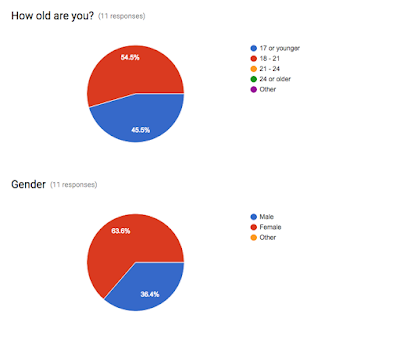 As part of my FMP I was tasked with conducting some primary research into my idea. I wanted to see what people thought of the noir style, how they would build a believable 1950s environment and how other films similar to mine achieved the look and feel that I want to mimic. To do this I utilised to methods, the first was creating a survey and putting it out online. In the questionnaire I asked for the age and gender of the participant to gauge what different demographics wanted. These were my results:
As part of my FMP I was tasked with conducting some primary research into my idea. I wanted to see what people thought of the noir style, how they would build a believable 1950s environment and how other films similar to mine achieved the look and feel that I want to mimic. To do this I utilised to methods, the first was creating a survey and putting it out online. In the questionnaire I asked for the age and gender of the participant to gauge what different demographics wanted. These were my results: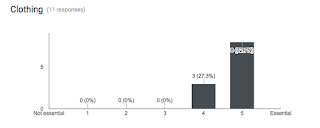
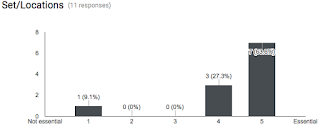 As you can see, the survey was mainly done by 18 to 21 year olds with the gender predominately being female. Next I asked them to rank a number of elements in levels of importance in creating a 1950's feel. The most important from are surveyors was clothing, with 72.7% of people putting it the essential need of the spectrum. However, all 3 choices (Clothing, Vehicles and locations) received at least 5 essential votes, showing how important all 3 elements are in creating a living breathing 50s world. The only one that got a 1 in importance was Locations.
As you can see, the survey was mainly done by 18 to 21 year olds with the gender predominately being female. Next I asked them to rank a number of elements in levels of importance in creating a 1950's feel. The most important from are surveyors was clothing, with 72.7% of people putting it the essential need of the spectrum. However, all 3 choices (Clothing, Vehicles and locations) received at least 5 essential votes, showing how important all 3 elements are in creating a living breathing 50s world. The only one that got a 1 in importance was Locations. 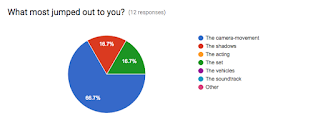 The final part of the survey came from watching the opening to "A touch of Evil" by Orson Welles as then answering which part of the scene caught the viewers attention most. It was clear that one element stood out above the rest. That being camera movement. The other two that share the remaining 33.4% are shadows and the set. Getting those 3 elements will be important in getting right during production.
The final part of the survey came from watching the opening to "A touch of Evil" by Orson Welles as then answering which part of the scene caught the viewers attention most. It was clear that one element stood out above the rest. That being camera movement. The other two that share the remaining 33.4% are shadows and the set. Getting those 3 elements will be important in getting right during production.The next part of my Primary research came from watching the aforementioned film, A touch of Evil. The classic film is famed for not only being a cinematic masterpiece but also it as hailed as the last proper noir film from the golden age of cinema. The film is directed by Orson Welles and stars Charlson Heston, Janet Leigh and Orson Welles in the crime drama. The story follows an investigation into a car bombing on the american side of the Mexico Boarder.
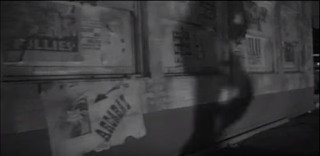
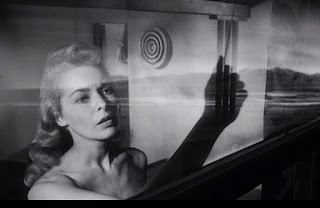 What I learned for watching the film was just how affectively you can use shadows and reflections to tell a story. For example, at the very beginning of the film we see a mysterious stranger plant a bomb in a mans car. As he runs towards the Vehicle, he casts a shadow on a large wall. This shot really hammers home that this is a shady characters whos identity will remain a secret and the only way to learn that secret is to watch the film. The use of reflections was also fascinating. It was obvious that mirrors and windows were placed and used strategically to add an extra dynamic to a scene.
What I learned for watching the film was just how affectively you can use shadows and reflections to tell a story. For example, at the very beginning of the film we see a mysterious stranger plant a bomb in a mans car. As he runs towards the Vehicle, he casts a shadow on a large wall. This shot really hammers home that this is a shady characters whos identity will remain a secret and the only way to learn that secret is to watch the film. The use of reflections was also fascinating. It was obvious that mirrors and windows were placed and used strategically to add an extra dynamic to a scene.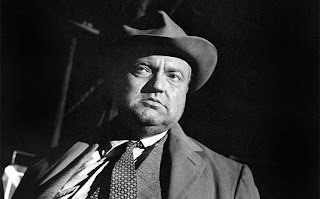
A good example of this technic is when Janet Leighs character opens the blinds of her motel to look out over the desert. Instead of it being a shot over her shoulder showing the view and the a reverse of her reaction, we get best of both worlds by the use of reflections. This adds a depth to the scene and visual intrigue that otherwise wouldn't exist.
Another shot type used throughout the film is the low angle shot. Now Orson Welles is famous for using low shots, even digging a hole in the studio to get the camera lower during filming of Citizen Kane. They are used predominately to show a character as powerful and he uses it with mastery. Take the opening shot where Orson Welles character, Hank is introduced. He is meant to be an intimidating man, and therefor having the camera low emphasises that idea.

No comments:
Post a Comment